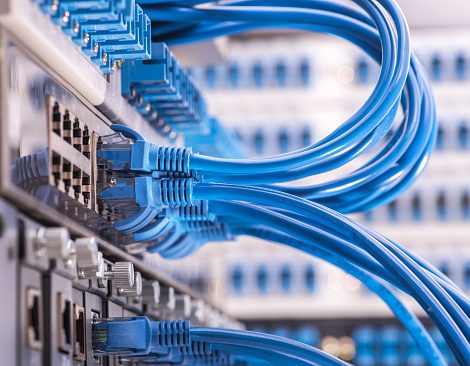Do you use a wired or wireless connection to access and transmit data? You may not think that it matters which you use, but it does.

When businesses set up, upgrade or relocate their data systems, they have a significant decision to make—What data can be accessed via a wireless connection, and what needs to be relegated to an Ethernet connection? To make an informed decision, it’s important to understand the advantages and disadvantages of both.
Ethernet Connections
An Ethernet connection is your basic Internet cable hookup. You run an Ethernet cable from a compatible device to the Ethernet port on your router or gateway to get Internet access. This option is attractive in its simplicity, but there are some important points to consider first.
- Security: A wired connection isn’t absolutely secure. You can still download malware, open phishing emails, and leave computers exposed to vulnerabilities with a wired connection. Nevertheless, it does protect against certain security troubles as opposed to wireless networks. Hackers can’t eavesdrop on data exchanges the way they can over unprotected wireless networks, and it’s one vector less to consider when creating a strategy to protect your most confidential data. Additionally, mobile devices tend to contain more vulnerabilities overall than desktops, so using a wired connection lowers the number of potential security mistakes that employees can make.
- Speed: Let’s give wireless connections their due here—When backed up by fiber optics and a powerful router, WiFi can be extremely fast—fast enough for most common tasks. However, Ethernet cables will always have a bit of an edge here. Data doesn’t need to be switched between as many formats, and doesn’t require a radio frequency to move data. This can make Ethernet anywhere from “a little bit faster” to “a whole lot faster” than a WiFi alternative. That’s important when your business needs to run important, data-intensive services.
- Reliability: An Ethernet connection poses relatively few problems when accessing an Internet connection. As long as your provider doesn’t go down, and no one trips over the cord, then you can pretty much depend on that cable providing you Internet access. This is useful if you need to keep services up and running for customers, or deploy processes that could last for hours.
- Physical Safety: Speaking of tripping over cords, Ethernet connections do have some downsides. They are physical lines that have to be strung throughout your work environment so that all your devices have Internet access. That’s not such a big deal in the server room. However, once you start planning for cable connections around the office, it can be quite complicated. It’s no surprise that many small businesses need to pay extra installation expenses to run cables everywhere. Find a place that’s pre-wired, or be prepared to pay some extra costs.
WiFi – Wireless Connections
You know what these are. You’ve doubtless set up a router and WiFi network for your home or business. These networks allow computers to connect to the Internet wirelessly, which is a particularly important option for using today’s mobile devices that don’t come with Ethernet ports. WiFi connections have come a long way in recent years, and can offer high-quality Internet access. However, they still have their limitations.
- Flexibility: This is why you have a wireless connection, right? It’s a mobile world out there, and you need mobile devices to survive in your industry. A WiFi connection allows you and your team to work where you want and how you want. It allows you to set up a broad variety of computers and smart devices exactly where you need them without worrying about running cables. It allows employees to continue using their mobile devices seamlessly when moving in and out of your office. It’s just handy to have, and we all know it.
- Facilitate Modern Features: There are some things you can only do with WiFi. You need it to provide customers free Internet connections. You can only manage a reasonable BYOD policy if you have WiFi. If you use an application for timesheets or check-ins, you’ll need WiFi. WiFi enables many important customer and employee solutions that can’t be obtained any other way.
- Time-Saving: Wireless networks don’t always save time (Setup procedures can take a while, as we all know.). However, once they’re up and running they do tend to be advantageous in the active workplace. When you no longer have to rush to a workstation to get an important task done, things tend to move more quickly. For example, we’ve seen plenty of increases in efficiency in factories, construction companies, and in inventory management when supervisors can make decisions and authorizations from their mobile devices.
- Variable Quality: Remember that wireless connections aren’t always dependable. They can experience interference and only cover so much territory. You can’t count on wireless quite as much as you can a wired connection, especially for important tasks.
- Security-Intensive: When you use a wireless network in place, you must invest in security. This means not only ensuring the right authentication and encryption are in place, but also that you maintain careful management over what applications employees use to access business data and where it can be accessed. It’s a whole new dimension of cybersecurity that requires plenty of additional regulations and controls.
What’s the Right Choice for Your Business?
From a broad perspective, you should keep sensitive data and more intensive processes to wired connections, and use wireless connections for sharing data and completing everyday work tasks that don’t require stringent security requirements. In practice, however, this quickly becomes a difficult guideline to follow.
For advice, or information on up-to-date strategies and solutions to manage your data, can help! We serve businesses in with a variety of services designed for their unique needs. Contact us at or to learn more.
